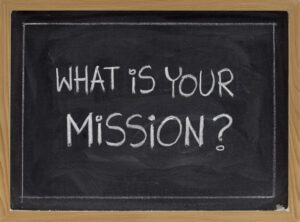Creating a mission statement is business 101, yet it’s something that many businesses overlook. However, companies with mission statements are more likely to provide their employees with a sense of purpose, boost morale, and unite teams around a common cause.
In our podcast episode, Creating Workplace Values, we spoke with Braxton Wood—Chief Career Mentor at Professional Pivots—about company core values, including mission statements and the role they play in the workplace.
According to a PWC report, 83% of employees prioritize meaningful work. People want to find meaning in their jobs and the work they do, and mission statements can help employees find that meaning. Today, we’re going to provide a step-by-step guide that covers how to create a mission statement. We’ll start with the basics of what mission statements are and why they matter, and we’ll finish up with a comprehensive guide on making one.
What is a Mission Statement?
Before you start writing a mission statement, it’s important to fully understand what a mission statement is.
A mission statement is a sentence or short paragraph that describes a company’s culture, goals, and values. In simpler terms, it’s a statement that explains why a company exists. It answers questions like, “what does the company do,” “what is the company’s goal,” “what products or services do they provide,” and “how does a company achieve those goals.”
For example, here is the mission statement of the American Red Cross:
“To prevent and alleviate human suffering in the face of emergencies by mobilizing the power of volunteers and the generosity of donors.”
This statement explains what they do (prevents and alleviates suffering), why (to help deal with suffering during emergencies), and how (mobilizing volunteers and donors).
Mission Vs. Vision Statement
Before moving on, let’s clear up some of the confusion between mission statements and vision statements. Creating a mission statement is hard enough as is, and you don’t need extra confusion in the mix.
While a mission statement is focused on what you do now, your current goals, and how you aim to achieve them, a vision statement is focused more on the long term aims and aspirations. It is what you aspire to be once you’ve reached your mission.
For example, your vision statement might include DEIB elements such as creating an equitable marketplace, while your mission statement might include short term goals around diversity and inclusion. The best way to think about them is short vs long term. A mission statement is about short-term goals and the here/now, while a vision statement is about what you hope to be in the long term and in the future.
Why Should You Have a Mission Statement?
The last thing to cover before moving on to how to write a mission statement is why you need it. Knowing the importance of a mission statement will help you write the best one possible, so let’s start there.
Well-written mission statements can provide numerous benefits such as helping give employees purpose and make their work meaningful, which can increase motivation, retention, and morale. People want to feel like they’re part of a greater whole working towards a common goal, and mission statements help accomplish that. They bring teams together, which is a point Wood made in our discussion as well, saying:
“I think core values can become a form of control, and that’s what I’ve seen happen. When it’s done right, it can be a form of inspiration. I think it’s so much easier to rally a team or organization around ‘look at how we’re helping our customers,’ ‘look at the successes our clients are having,’ instead of ‘look at what the company’s doing.’”
Creating a mission statement also helps prevent negative thought patterns in the workplace such as toxicity, jealousy, resenteeism, absenteeism, and more.
How to Write a Mission Statement

Now that you have all the information needed, let’s cover how to create a mission statement for your business. We’ll go step-by-step, making it as simple as possible.
1. Understand What’s Needed
First you need to understand what’s needed. The three core components of creating a mission statement are the goal, audience, and method. The goal is fairly self-explanatory; your mission statement needs a goal your business aims to achieve, such as providing a service to other businesses or providing customers with a necessary product.
The audience is also relatively simple. You need to know the audience for your mission statement, which typically includes your employees and customers. Then you need the method, which is how you aim to achieve your goals. Going back to the American Red Cross example from earlier, their method is mobilizing volunteers and donors.
2. Identify Your Audience
Next you need to focus on identifying your audience. Who exactly are they? What are their preferences? How can you best craft your mission statement to suit the audience? Again, this typically covers employees and customers, so don’t focus entirely on one or the other. A mission statement not only helps employees understand the company and its goals, but it also helps customers understand what the company is all about.
Don’t be afraid to ask questions, talk to people, or do surveys. The better you understand your audience, the better you can go about creating a mission statement that encompasses your goals.
3. List the Company Goals
After that, you should list the company goals. Many of these may not make it into the final mission statement, but listing them all out will help you get a better idea of what your goals are, and which ones are most important.
These goals might be things like providing a crucial service to businesses, empowering customers with your service, or helping those in need. Regardless of what they are, identify your goals and list them out so you have a lot to work with when making a first draft.

4. Explain the Method
Now you need to look at the method—how you aim to achieve those goals. The method is usually easy to identify since it is what your company does on a daily basis. For example, a team building company may aim to achieve their goal of uniting teams and leaving a positive impact on the world through putting on innovative charity events.
Identify and explain your method. This is a key part of creating a mission statement, and it’s helpful to have your methods written down prior to making a draft.
5. Write a First Draft
Once all that’s done, it’s time to write a first draft. Look at other examples to get an idea of what a good mission statement looks like, consider the notes you’ve taken in the previous steps, and use that to create a draft.
Remember this is just a draft. It won’t be perfect, and that’s okay. This is just a starting point. You’ll refine it further later on. The focus now is just getting something on paper to work with.
6. Gather Feedback
With a draft in hand, now you can gather feedback. This is incredibly important since feedback can help you improve your mission statement and make it more effective.
Wood offered some helpful insights on feedback during our discussion. He said:
“I need to make sure that I’m doing it to improve, if not maintain, a good morale. So that’s the first step. Once you’re in a position that your team knows that you’re on their side, you’re in their corner, and you’re in a position where they can trust that their feedback is safe. That’s the point you got to get to. I think it’s easy to have a conversation at that point.”
So have open conversations, gather feedback, and take it to heart. You don’t have to make every change suggested, but give feedback proper consideration and use it to improve your draft.
7. Finalize the Mission Statement
The last step in creating a mission statement is finalizing it. Use all the feedback you gathered to make changes and adjustments to it, creating the best mission statement possible.
Just follow the steps provided, make sure you have all the necessary elements, consider the feedback, and do your best. If you have all the elements and listened to feedback, you should have no problem creating a mission statement that’s effective.
Mission Statement Examples
To wrap up, let’s look at a couple examples of great mission statements. These are effective mission statements that communicate goals, bring teams together and build synergy, and explain what the organization is all about.
Here is the mission statement of IKEA, the popular and affordable home furnishing brand:
“To offer a wide range of well-designed, functional home furnishing products at prices so low that as many people as possible will be able to afford them.”
This statement explains what IKEA does, how, and why in a single short sentence. It provides customers and employees with a quick understanding of what they do and what kind of company they are. And for another example, here is Disney’s mission statement:
“To entertain, inform, and inspire people around the globe through the power of unparalleled storytelling.”
This mission statement answers all the big questions like what (to entertain, inform, and inspire) and how (the power of storytelling). Again, it explains who Disney is and what they’re about simply and concisely. Keep these examples in mind as you’re creating a mission statement for your business.
Embody Your Mission Statement

Creating a mission statement may not seem that important in the grand scheme, but it can have a big impact on morale, retention, public perception and more. Team building is an effective tool to help employees more deeply connect with and embody the values laid out in a mission statement, making it a must for businesses.
If you’re ready to embody your mission statement, consider TeamBonding. We can help facilitate team building events that help connect you and your employees with your values, resulting in a closer, more effective workforce. So check out our events and get in touch with us today to start making your mission statement a reality.














